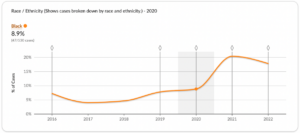Why High-Quality Data Matters in the Criminal Justice System
When we talk about the importance of criminal justice data, we implicitly mean high-quality data. But the fact is, there are over 3,000 counties in this country, each with its own criminal justice system and its own set of rules, policies, and no universal standards for how to record or input data. This means that on any given day, the same data on the same crime can be recorded in totally different ways.
Taking this all into account, it’s hard to standardize criminal justice data across the country.
Data aren’t collected for the purposes of aggregation and decision-making, so there’s a need to retrofit old systems to new standards, but prosecutors and police chiefs aren’t data experts and they shouldn’t have to be. However, they should be able to trust their data enough to make good decisions for their communities, and that’s where Measures for Justice can help.
Every Data Point Represents a Human Being
When criminal justice cases are mislabeled, or recorded improperly, they can get ignored.
And since every criminal justice data point represents a life, it is almost impossible to see the bigger picture all those lives create when there isn’t accurate data to consult.
Here are some real-world examples of what we’ve encountered while working in communities, and the results we saw concerning their data practices.
-
- An Agency that did not record any misdemeanor data in their case management system.
- The result: an entire case type is left un-trackable.
- A county that had the word “burglary” recorded 30 times, each time with a different typo.
- The result: 30 cases that can’t be grouped together for analysis because the top charge is different in each one.
- A county with ten diversion programs where data for each program sits in a different office and none is connected to the prosecutor’s data.
- The result: No one is able to track diversions across the county in a meaningful way.
- A county prosecutor office that thinks it’s entered all its filing dates, but in reality one-third are missing.
- The result: How the office handled one third of cases in that county cannot be evaluated, and, for budgeting purposes, ⅓ of cases went uncounted.
- An Agency that did not record any misdemeanor data in their case management system.
If all these counties had high-quality standards–which include quality controls, standard structures for entering charge codes, rules for what data needs to be collected, and rules for connecting data sources–none of these problems would have been possible.
This is why we focus so much on helping counties get to more complete data, and we’ve been doing this work for a long time now.
Our Work
In 2011, we set out to develop a data standard for courts, (i.e., what data elements should be collected by every agency and reported out) and developed a unique methodology and code book to standardize data across counties. We measured 1,200 counties – 20 states’ worth of data- and watched as our standard was codified into law in Florida.
Most recently, we have been tailoring our court standard and methodology to prosecutor and police data.
But our work does not stop there. Good data is part of a larger protocol for accountability in criminal justice that includes community engagement. Why? Because when an engaged community comes to the table with data as their language, they are able to work with their public servants to pursue policy change and reform.
To these ends, we work with community leaders and community based organizations (CBOs) on data literacy, outreach, and mobilization.
The results we’ve seen have proven that our approach–developing a standardized model for measuring the system, and giving communities the tools they need to make the changes they want to see–works.
Here’s just one example of the impact high-quality, transparent data can have.
In 2021, we released a data platform called Commons that engages the public and their public servants around high-quality data, the result being a place for transparent, accessible data and data-driven policy goals.
In Yolo County, California, the District Attorney’s office launched their Commons with a goal of increasing felony diversions to 10% by September 2022.
The problem was:
Shortly after Commons launched, the D.A. and community members began noticing that the police had been disparately arresting people of color. At that time, the D.A.’s office also had a policy that disqualified any defendant from being eligible for diversion if they had a prior offense within 3-5 years. The outcome was lower diversion rates for Black defendants.
The solution was:
Good data and a community that used it to seek change. Based on data showing a) racially disparate arrests; b) lower rates of diversion for Black defendants; and c) the D.A. ‘s progress towards increasing diversions, the office decided to revoke a years-old policy and widen the pool of defendants who were eligible for diversion. The change was announced just one month after Commons launched.
The Results in Numbers
Percent of Black defendants diverted before Commons:
- 5% of felonies involving Black defendants (2020)
- 8.9% of all cases involving Black defendants (2020)
Percent of Black defendants diverted after Commons:
- 8.6% of felonies involving Black defendants (2022)
- 17.9% of all cases involving Black defendants (2022)
Yolo County Diversion rate in 2020 (for cases involving Black defendants)

Yolo County Diversion rate in 2022 (for cases involving Black defendants)

We know high-quality data makes a difference in communities. It changes lives. So that’s why we’re on a mission to bring high-quality data available nationwide.
If you’re looking to bring better data to your community, we’d love to help with our multiple criminal justice data solutions, and check out all the ways you can get involved in the work we do every day in communities across the country.